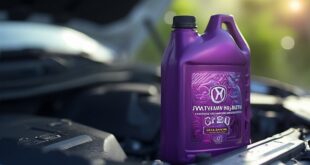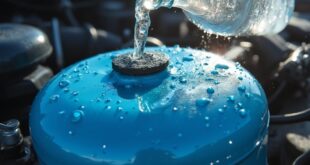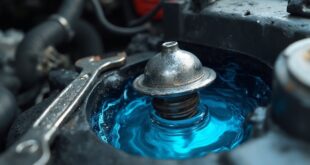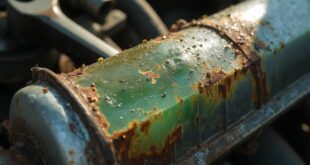If your car's revving in park, it could signal several issues. A faulty idle air control (IAC) valve, a stuck throttle cable, or a defective accelerator pedal position sensor may be at fault. Vacuum leaks or a dirty throttle body can also cause RPM spikes. It's essential to inspect these components and perform maintenance to keep your engine running smoothly. Want to know more about diagnosing and fixing these problems? Keep going to find out!
Common Causes of Revving in Park
When you notice your car revving in park, it can be both confusing and concerning. Several common causes might be at play.
A bad IAC (Idle Air Control) valve can lead to erratic idling, while a defective accelerator pedal position sensor may send incorrect signals, causing unexpected revs.
In older models, a stuck throttle cable can keep RPMs high. Additionally, activating the AC during a cold start can temporarily increase your RPMs.
Mechanical issues, like vacuum leaks or a stuck IAC valve, are significant contributors too.
Identifying the root cause is essential for resolving the problem effectively.
Throttle Body and Vacuum System Issues
The throttle body plays an essential role in regulating your engine's air intake, and if it becomes dirty or damaged, it can stick, leading to unexpected RPM spikes.
An erratic idle might signal a malfunctioning throttle body, so regular cleaning is vital to prevent buildup and maintain performance. If cleaning doesn't fix the problem, you may need a replacement.
Additionally, vacuum leaks can disrupt your engine's air-fuel ratio, causing RPM fluctuations. Check for brittle or cracked vacuum hoses, as they're common culprits.
A smoke test can help identify hidden leaks, ensuring efficient engine operation and performance.
Electrical and Sensor Failures
Electrical and sensor failures can considerably contribute to your car's revving issues while in park. A malfunctioning IAC (Idle Air Control) valve disrupts idle speed, possibly leading to stalling.
The accelerator pedal position sensor monitors your pedal's position for throttle control; damaged wiring here can cause erratic RPM behavior. It's crucial to check the integrity of all wiring connections for proper sensor function.
Visual inspections and diagnostic tools can help pinpoint electrical issues, but you might need professional assistance for more complex problems. Addressing these failures promptly can help restore your car's normal behavior and improve overall performance.
Diagnostic Steps for Identifying Revving Issues
Addressing electrical and sensor failures is just the first step in tackling revving issues.
Start by checking if the air conditioning system is running, as it can temporarily raise RPMs. Next, read any trouble codes from your car's computer for insights into underlying problems.
Clean the throttle body to remove dirt buildup and inspect for vacuum leaks in hoses. Finally, check the accelerator pedal position sensor data to identify any faults.
If you're unsure or the issues persist, consulting a professional mechanic can help you pinpoint and resolve the revving problem effectively.
Solutions for Throttle Body and Sensor Problems
When dealing with throttle body and sensor problems, taking prompt action can prevent further complications.
Start by cleaning the throttle body to remove dirt that could cause sticking. If issues persist, consider replacing it entirely.
Inspect vacuum hoses for cracks or brittleness, as leaks disrupt air-fuel ratios. Conduct a smoke test to identify hidden leaks.
Check the accelerator pedal position sensor for damage; faulty wiring can lead to erratic RPMs.
If you're unsure or the problem continues, consulting a professional mechanic is a wise choice.
Addressing these issues quickly can restore your car's performance and stability.
The Importance of Regular Car Maintenance
Regular car maintenance plays an essential role in preventing issues like throttle body and sensor problems from escalating. By routinely checking and cleaning these components, you can enhance performance and avoid costly repairs.
Regular inspections of the IAC valve and accelerator pedal position sensor help catch potential failures early. Keeping wiring and connections in good shape is vital, too.
Plus, proactive troubleshooting guarantees you address any signs of trouble, like erratic idling or unusual revving. Ultimately, staying on top of maintenance not only guarantees a smoother ride but prolongs your vehicle's lifespan, saving you time and money in the long run.
When to Seek Professional Help
If you're experiencing persistent revving while your car is in park, it's crucial to recognize when it's time to consult a professional.
If simple troubleshooting steps, like checking the air conditioning or cleaning the throttle body, don't resolve the issue, don't hesitate to seek help.
Unusual behavior, such as erratic idling or stalling, indicates potential sensor or electrical problems that require expert diagnosis.
Additionally, if you notice warning lights on your dashboard or the problem worsens, it's best to visit a mechanic.
Proactive attention can prevent further damage and guarantee your car runs smoothly.
Frequently Asked Questions
Can Revving in Park Damage My Car's Engine?
Yes, revving in park can damage your engine. Continuous high RPMs lead to overheating, increased wear, and potential component failure. It's essential to address the underlying issue promptly to protect your vehicle's performance and longevity.
How Can I Prevent My Car From Revving in Park?
To prevent your car from revving in park, regularly inspect the throttle body and vacuum systems, verify the IAC valve functions properly, and check the accelerator pedal sensor to maintain smooth performance.
Does Weather Affect Revving Issues in Cars?
Yes, weather can affect revving issues in cars. Cold temperatures might cause higher RPMs during warm-up, while humidity and heat can impact engine performance. Always monitor your car's behavior in varying weather conditions for potential problems.
Can a Dirty Air Filter Cause Revving Problems?
Yes, a dirty air filter can cause revving problems. When airflow's restricted, your engine struggles to maintain peak performance, leading to erratic RPMs. Regularly check and replace your air filter to guarantee smooth engine operation.
What Are the Symptoms of a Failing Throttle Cable?
You might notice symptoms like inconsistent acceleration, difficulty shifting gears, or a stuck pedal if your throttle cable's failing. Additionally, you could experience unexpected RPM increases, affecting overall vehicle performance and driving comfort.
 Car Service Land Coupons for Oil change, Tires, Wheel alignment, Brakes, Maintenance
Car Service Land Coupons for Oil change, Tires, Wheel alignment, Brakes, Maintenance




